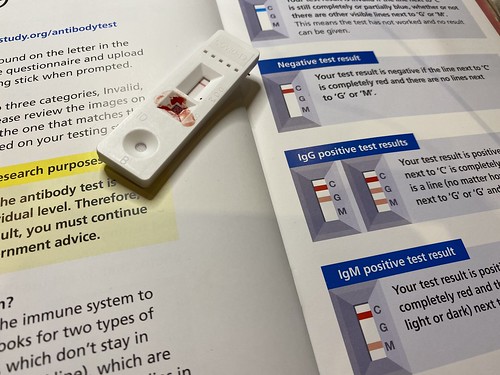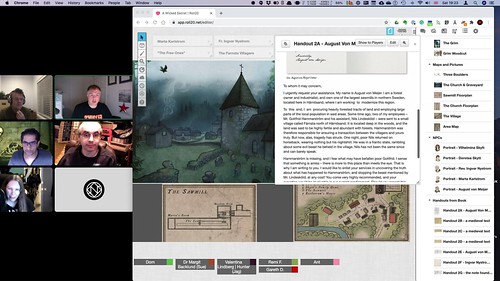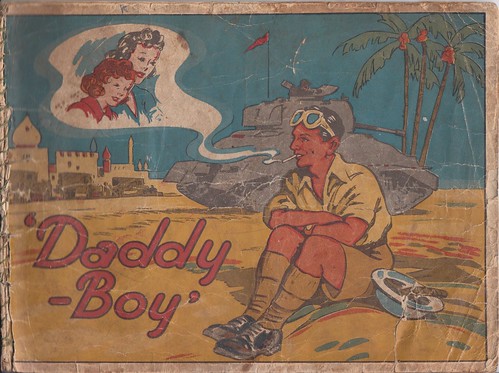
Dr Mitch couldn't join us tonight so the rest of the players decided that the best way forward was to explore all the subplots rather than go straight forward with the plot as we left it. As a result, I ended up parking where I thought we'd be going until next time. No plan survives contact with the enemy, sorry, the players.
Our dramatis personae:
Ser Alys de Rouge (a half-orc Fighter with a soldier background, currently the leader of the town militia of Daggerford), played by Tom (Guvnor). Lawful Neutral
Kelwarin (Kel) (a half-elf Sorceror flush with the powers of wild magic, an outlander), played by Graham (First Age). Chaotic Good.
Gaddock Teeg (a halfling wizard and former prizefighter), played by Alex (Doggetay), Neutral Good
Ser Adon of House Starbright (a half-orc Paladin, from a knightly background, with two human retainers and a priest), played by Paul (dr_mitch). Lawful Good.
November 8th
The rest of the night passed without any more disturbances from the creatures of Strahd, and the vampire himself did not return. Ser Alys, Kel and Gaddock decided to investigate the fate of Gertruda, as promised to her mother by Ser Adon the previous day. Ser Adon consulted with Ismark and Ireena on plans for how to get their father buried and her to Vallaki and safety.
Ser Alys started her questions at Bildrath's Mercantile, the only notable store - overpriced, of course - in Barovia Village. Talking to the proprietor, Bildrath Cantemir, she established that Gertruda was from a very sheltered background with an overly protective mother. She had often come to the store on errands, but less often lately. She used to hang out with Gloreena and Elizabet who lived across the square. Bildrath assumed that she'd been taken by one of the creatures of the night, as there hadn't been any Vistani in town to spirit her away. Taking one last look at the eye-watering prices, Ser Alys left to seek out the girls.
Meanwhile, Gaddock headed back to the 'Blood on the Vine' Inn for second breakfast with a helping of gossip. The barkeep, Arik, was as taciturn as ever, but very soon he managed to be entertained by the lovely Alenka, who came out from the kitchen to chat with him. He found more about the mage who came and tried to lead an attack on Castle Ravenloft, an attack which had been defeated and left people missing. Apparently, the Priest Donavitch's son Doru was one of the few who had returned but no-one had seen him since and people were afraid to visit Church. She also discussed who Gertruda's friends were, and suggested that perhaps she had ended up at the castle as Count Strahd often took 'brides'.
Kelwarin headed to the Church of the Morninglord to meet with Fr Donavich to try and find if there were any clues to Gertruda's fate that the priest knew about. As he reached the church at the edge of town he suddenly realised just how exposed he was. To the north of the church was the cemetery and beyond that the heart-stone of rock which Castle Ravenloft was built upon. The mists swirled around as he knocked on the scarred, burnt and clawed doors. Something had been trying to get in. The prayers stopped and a hoarse voice called out to him that they were coming. Kel heard a scream from somewhere in the building. Entering, he met the wide-eyed stare of Fr Donavich, a man who was clearly struggling to hold it together. The church was smashed up, and Kel heard tortured cries from a room by the entrance, cries to a Father, asking to be fed, saying that he hadn't been fed since he returned. Father Donavich admitted that it was his son, Doru, who was 'unwell' and needed to be locked up for his own protection. Kel realised that the son had probably been turned by the Count and decided that going to meet him was a bad idea, especially as he could hear the boy pleading to his father to bring the visitor to him. Instead, he went with the priest to the altar and prayed for the salvation of his child and the village, a prayer he feared was unanswered. Kel promised to try and help the priest save his son, and left as soon as he could - forgetting to mention that they needed to arrange a funeral for the Burgomaster as well.
Ser Alys visited Gloreena and Elizabet's house and met their father who seemed to have no spark of life or personality, a bit like the barkeep. His wife, a cheerful woman, soon came to the door but wouldn't invite her guest in. After some persuasion, she let the girls talk to Ser Alys across the threshold. The girls confirmed that there was no special man in Gertruda's life - although she had talked about a dark, handsome stranger with piercing eyes who she had been seeing. They hadn't believed this, assuming that it was an idle daydream. Suspicious, Ser Alys headed back to the store and ended up having a conversation with Bildrath's somewhat simple nephew, Parriwimple, who was much the same age as Gertruda. He knew nothing about a boyfriend and clearly liked Gertruda. However, Ser Alys was convinced that the boy had not been involved in any foul play.
Our three brave adventurers regrouped at the inn just after Gaddock had finished second breakfast, at which point they ordered first lunch. They found Gaddock talking to Lavinia (Sorja) who had sent her sister back to the kitchen but added little to the gossip. They asked more about Madame Eva and resolved to head out of town for the four miles journey to the Vistani encampment beside the Tser Pool, for which they'd obtained directions. Their plan was to ask Madame Eva for a reading of Gertruda's future using the Tarokka.
Setting off, their journey was uneventful. At the River Ivlis crossroads, they discovered an old gallows and spotted that a raven was watching them again. As they left the gallows behind, they heard a noise and turning, saw a hanged figure swinging on the gallows through the mist. Gaddock suddenly realised that it looked just like him, but the others didn't see this at all. They just saw a human figure, not a halfling. When they checked, there wasn't a body hanging from the gallows at all.
Reaching the pool, they swiftly met Madame Eva and crossed her palm with silver for a reading of Gertruda's future.
The first card - the past - was the Enchanter, symbolising that someone had bewitched Gertruda and ensorceled her away.
The second card - the present - was the Donjon, symbolising that she was held somewhere from which she couldn't leave.
The third card - the future - was the Elementalist, symbolising that the child's nature would be changed fundamentally.
The party immediately suspected that she must be in the castle. When Madame Eva asked them, they agreed to have their fortune read, thus tying their futures into the skein of fate that the Dark Powers have wrapped Ravenloft in.
Madame Eva dealt five cards on the table, and this is what she saw.
2 of Coins — Philanthropist
This card tells of history. Knowledge of the ancient will help you better understand your enemy. Look to a place where sickness and madness are bred. Where children once cried, the treasure lies still.
7 of Glyphs — Charlatan
This card tells of a powerful force for good and protection, a holy symbol of great hope. I see a lonely mill on a precipice. The treasure lies within.
2 of Swords — Paladin
This is a card of power and strength. It tells of a weapon of vengeance: a sword of sunlight. I see a sleeping prince, a servant of light and the brother of darkness. The treasure lies with him.
Raven (Queen of Clubs)
This card sheds light on one who will help you greatly in the battle against darkness. Find the leader of the feathered ones who live among the vines. Though old, he has one more fight left in him.
Ghost (King of Hearts)
Your enemy is a creature of darkness, whose powers are beyond mortality. This card will lead you to him. Look to the father’s tomb.
Confused about what to make of their fate, the group decided to spend the night with Vistani and to hire a Vistani hunter with dogs to help them to try and find the trail for Gertruda the next day. During discussions around the campfire, the party found out more about the actions of the Mage M---------- who had led the uprising against Strahd the year before.
November 9th
The next day was mainly spent combing the woods and roads around and in Barovia Village with the dogs, searching for a scent of the missing girl. The party also went high enough up the slope to see the rest of the valley. They found a scent back near Gertruda's house, and a snag of a dress which suggested that she may have been taken into the air from on top of the roof above the well the family used. Checking her room, they established that there was evidence (handprints and wear on the lock) which suggested that Gertruda had found a way to get outside despite the efforts of her mother, Mary, to protect her.
Retiring to the Blood on the Vine, they discussed whether they should try visiting Castle Ravenloft to see if she was there. Gaddock was convinced he could charm Strahd. Undecided, they resolved to get the Burgomaster buried before they took the next step.
GM Notes:
This ended up being a very different session to the one I'd planned (but that can wait), with lots of investigation and no combat. The game has just reset from my perspective, as my initial Tarokka reading has now been overwritten. It's getting interesting. This was the tenth session in the campaign and we are 12 game days on since we began. Worth adding that the reading for Gertruda was completely random and made up and worked wonderfully.
Curse of Strahd will return on 21st October 2020.
7th October 2020













